|

by Andrew Collins
from
AndrewCollins Website
'This is the truth, the whole
truth and nothing but the truth:
As below, so above; and as above so below.
With this knowledge alone you may work miracles.
And since all things exist in and emanate from the ONE Who is the
ultimate Cause,
so all things are born after their kind from this ONE.'
The Emerald Tablet of Hermes Trismegistus
(as translated by the
elusive alchemist Fulcanelli)
Contents
-
'I am One'
-
The Coming of the Green Stone
-
The St George's Parry
-
The Knights Hill Pool
-
'Meonia fore Marye'
-
The Quest for the Green Stone Resumes
-
The Swan's Neck Discovered
-
The Rosicrucian Enlightenment
-
The Catholic Cause in England
-
The Swan in the Tower
-
The Green Stone Found
-
Independent Verification of the Green Stone Story
-
Lady Mary Yate and the Martyr of Harvington
-
The Rebirth of Psychic Questing
-
Meonia and Iona
-
The Lights of Knowledge
-
The Seven Swords of Meonia
-
A New Star in Cygnus
-
The Influences of Venus
-
Bride-Bridget - the White Swan
-
The Cygnus Mystery
-
Meonia.com
BookList
i. I am One
The name of the Andrew Collins-Questing Conference website, and
everything that it entails, is MEONIA (pronounced mê as in knee, ô
as in gô, nia, as in wire). It is an anagram of 'I am One', with One
being the name given to the Supreme Being, the creative force of the
universe, in various religions from the Hermetic mysteries of Egypt
('all things exist in and emanate from the ONE'), through to
Hebraism ('Hear, O Israel: the LORD our God, the LORD is One', Deut.
vi, 4, Hebrew Bible) and Islam ('He is God, the One, God the
eternal', Sura cxii).
The One might be seen as the expression of the macrocosm as a whole,
reflected in microcosm within nature, within ourselves and within
our every action in life. One effects the other, and vice versa,
leading to the above Hermetic axiom of: 'As above, so below'.
MEONIA as a word was first revealed by my friend and colleague
Graham Phillips under hypnosis during the late afternoon of
Wednesday, 17 October 1979. We shared a house in Wolverhampton in
the West Midlands, which doubled up as the headquarters for the
newsstand magazine STRANGE PHENOMENA, to which at the time we had
both dedicated our lives. I arrived home from a meeting with the
printers to find him in an agitated state.
He felt that something
was trying to 'get through', so I offered to put him under hypnosis
to see what might occur. After some discomfort, Graham relaxed, and
I found myself speaking to a secondary personality who answered to
the name of 'Joanna' (supposedly a living person - an old friend of
his from his time at Exeter Art College).
MEONIA was offered by 'Joanna' as a name for the Philosopher's
Stone, the material substance sought by medieval alchemists to
achieve a state of spiritual completion and perfection, cloaked
under the guise of the transmutation of base metal into gold.
There
is no question that the ancients saw the
Emerald Tablet of Hermes Trismegistus as an expression of this stone, looked on as a vehicle
that enabled the practitioner to achieve oneness with the Supreme
Being, the Hermetic concept of the One. In this way, the statement
'I am One', encoded in the word MEONIA, makes sense of its apparent
connection not only with the Philosopher's Stone, but also the
Emerald Tablet itself.
Back To Contents
ii. The Coming of the Green Stone
That the enigmatic 'tablet' of Hermes, the 'thrice great', was
described as 'emerald', a term used in the Graeco-Egyptian language
to refer to green-coloured stone in general (such as green granites,
green jasper and even green glass) was fortuitous, for 'Joanna'
claimed that MEONIA was the name of a fabled green stone glimpsed in
mind only that morning by an acquaintance - a talented psychic,
named Alan Beard, who lived in Alsager, Cheshire.
Unexpectedly, an
image had appeared in his head of an oval stone the 'size of a
sixpence' suspended in midair. It was green in colour with an
unearthly radiance, and around it stood a group of people gazing up
at this wondrous object.
Speaking to me on the telephone that morning, Alan admitted that he
had no idea what this image meant. However, he linked the green
stone with an earlier vision experienced just two days earlier on
Monday, 15 October, in which he had seen in his mind's eye the same
or a similar object, without any colour on that occasion. It had
appeared initially the size of a loaf of bread before shrinking down
to the size and shape of an egg, before finally it became an
oval-shaped stone, a cabochon, worn in a ring by a woman.
Accompanying this imagery, which had occurred whilst on the
telephone to me, had been the sight of a stone plinth or table-like
slab, recalling, as we were much later to realize, the Emerald
Tablet of Hermes. Indeed, there had been no reason whatsoever why
Alan should have been glimpsing the strange green stone before
'Joanna' had implied, quite unexpectedly, that it was a real object
that we now had to find using whatever means were at our disposal.
Back To Contents
iii. The St George's Parry
We were told to start our quest by visiting Harvington Hall, the
moated medieval and Elizabethan home of Sir Humphrey Packington. He
was a recusant, a Catholic subject to legal and social penalties
through refusing to convert to Protestantism, who was around in 1605
when the sons of several local Catholic families lost their lives in
the ill-conceived and ill-fated Gunpowder Plot. Packington had
apparently taken possession of the Meonia Stone around the time of
the arrest of the main conspirators, hiding it somewhere that no one
would find it.
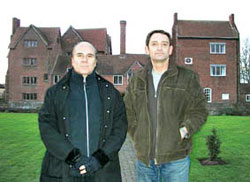
Andrew Collins & Graham Phillips
outside Harvington Hall
This information led us to note potential clues among the remaining
murals in a first-floor corridor of the hall which portrayed the
Nine Worthies, nine great heroes of history (usually three biblical,
three legendary and three historical).
They drew us to consider the
importance of a distinctive sword stance displayed by at least two
of the 'worthies', the strong man Samson and the giant-slayer David.
Known as the St George's Parry (where the weapon is held
horizontally above the head to block an attack), it persuaded us to
research the possible relevance of knighthood, chivalry and the saga
of King Arthur and the Knights of the Round Table to the Green Stone
story.
We even felt that the St George's Parry might be a clue
pointing towards the importance of the familiar image of King
Arthur's sword Excalibur held in a horizontal position by the Lady
of the Lake. Perhaps we were looking for a concealment place on an
island in the middle of a lake, somewhere in the Worcestershire
landscape.
Back To Contents
iv. Knights Hill Pool
Our historical detective work led Graham and I to focus our
attentions on an isolated pool on the estate of the Earl of
Coventry, beneath Knights Hill, near Severn Stoke in Worcestershire.
About to inspect the site first-hand, believing that the Green Stone
(as it became known) was to be found there, Alan unexpectedly rang.
We had not spoken to him for some days, and he knew nothing about
the latest developments.
Without saying a word of what had been
happening, he spoke of experiencing another vision, the first since
glimpsing the Green Stone. He now felt that we were looking not for
the stone at this time, but an 'indicator' that would eventually
lead us to the stone, and this would be a sword.
This baffled us, as
prior to this time there had been no indication that anything else
other than the Green Stone was on offer here. However, we took on
board what he said, and headed immediately out to the Knights Hill
Pool, a journey of about an hour from Wolverhampton.
Back To Contents
v. Meonia for Marye
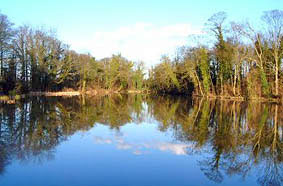
The Knights Hill Pool
The date was Monday, 23 October 1979, and that night, after some
effort, Graham and I retrieved a short steel sword from behind an
age-old dry stone wall holding up the bank next to a small brick
footbridge at one end of the pool. It was covered in ivy and
protected by thick undergrowth, making it extremely difficult to
access. There is no way that anyone had been there for a very long
time indeed.
The sword was found in a small cavity, behind the ninth stone down
and along from the bridge (nine was a recurring number in the
quest). It was hermetically sealed in a thick bobbly layer of
brown-green resin, which on removal revealed a pristine sword with
an inscription along the blade that read 'Meonia fore Marye'.
The 'Marye' implied in the inscription was thought to be Mary Queen
of Scots, the Catholic monarch imprisoned by Queen Elizabeth after
being accused of plotting against her. For the remainder of her
troubled life, Mary Stuart was frequently moved between castles in
the north and Midlands of England, until finally she reached
Fotheringhay in Northants, where she was executed in 1587.
'Joanna'
claimed that Mary possessed the Meonia Stone, wearing it on a ring,
before passing it on to a young Robert Catesby (1573-1605), the
leader of the Gunpowder Plot. Apparently, he had been taken to see
her with his father Sir William Catesby, himself a recusant, when
she was imprisoned in the neighbouring county of Staffordshire two
years before her death.
Following the collapse of the Gunpowder
Plot, Catesby supposedly gave the stone into the care of Lady
Gertrude Wintour, the wife of Robert Wyntour of Huddington, another
of the leading conspirators. She in turn has passed it on to
Humphrey Packington at Harvington Hall, who was not implicated in
the plot, and thus could be trusted with the stone.
Back To Contents
vi. The Quest for the Green Stone Resumes
So just six days after the name MEONIA had first been revealed, its
independent existence was confirmed through the discovery of the
sword, but the quest did not end there. Following four straight days
delivering thousands of copies of STRANGE PHENOMENA's second issue,
Graham and I returned to Wolverhampton and resumed the quest, which
'Joanna' implied had to be completed by 31st October, now just four
days away.
One day was wasted in the proximity of Meon Hill, a
mysterious location associated in the past with a gruesome
witchcraft-linked killing, drawn principally by its tantalising
place-name. 'Meon' had seemed to imply MEONIA, but we were being
drawn away from the true quest.
We had forgotten that Alan Beard had
said that the sword would be used as an 'indicator' to find the
stone, and so during the mid evening, about to spend a night in a
hotel at Moreton-on-the-Marsh in the Cotswolds, we were convinced by
a friend named Marion Sunderland, who lived in Flint, North Wales,
and her teenage daughter Gaynor, a high profile UFO contactee, that
we should return as soon as possible to the Knight's Hill Pool,
where they would help us find the illusive stone.
So this is what happened the next day, Monday, 29 October. Standing
on the footbridge next to where the sword was found, Gaynor used the
ceremonial weapon (found to be of nineteenth century manufacture) as
a divining instrument, rotating it clockwise until she felt drawn to
a particular direction. Here, she said, some 'two miles' away, we
would find a 'ruined building', an 'abbey' perhaps, which held an
important clue to the quest.
Sure enough, there was a 'ruin' exactly where she had indicated. It
was located at a place called Dunstall Common. Yet it turned out to
be not an 'abbey', but a sham castle, built in the eighteenth
century by the landscape architect Capability Brown as part of the
estate of the Earl of Coventry. The folly bore impressive square and
round towers, one of which was accessible, enabling Graham, Gaynor
and I to climb its spiral staircase.
We trod carefully in the
partial darkness, but then became concerned by the sound of beating
wings above us. It was accompanied by the fall of loose debris which
came cascading downwards on to our heads. Assuming that a large bird
blocked our way to the top, we turned back and headed out of the
mysterious tower (it was probably only pigeons!).
Back To Contents
vii. The Swan's Neck Discovered
That night, at Marion and Gaynor's home, a small group gathered
around an OS map of the Worcestershire landscape looking for further
clues to the quest, feeling like our luck was finally running out.
Fred Sunderland, Marion's husband, narrowed down the search by
ringing an area that included those sites already singled out as
important in some way. It was here that we should concentrate our
efforts to find a location, he suggested.
About to give up, Marion
flicked through a book on Mary Queen of Scots and noticed how the
Catholic monarch embroidered pictures of waterfowl (she said
'swans'), with their necks in an unusual U-shaped position. Marion
mentioned this out aloud, at which Graham's eyes fell upon a bend on
the River Avon called the Swan's Neck located firmly within our
designated search area. Stabbing the map he exclaimed that he had
found 'it', and now felt sick inside.
We all looked and saw the
Swan's Neck marked. It was important not simply because of the
tangential link with Mary Queen of Scots, but because a new star
(actually a supernova) that had appeared in the year 1600 within
Cygnus, the celestial swan, was seen by those awaiting a new age of
enlightenment as a divine sign of its imminent arrival.
Back To Contents
viii. The Rosicrucian Enlightenment
As ill-conceived as the Gunpowder Plot might seem today, it sprang
from the vented anger and frustration of suppressed English
Catholics, who were being fined and penalized simply for refusing to
recant the faith of their ancestors. They expected emancipation when
Mary Queen of Scots's son James I (James VI of Scotland) succeeded
Queen Elizabeth to the throne in 1603.
Yet not only did this not
happen, but James became even more fanatical than Elizabeth,
tightening his grip on the Catholics and initiating terrible witch
persecutions up and down the country. He even wrote a much-reviled
book on how to find out whether a person was a witch, or in touch
with demons, devils and spirit familiars.
It was a dark time, and the swan became the symbol of a hoped for
new age not only among free-thinking Protestants, united under the
mystical symbol of the Rose upon the Cross, but perhaps also the
Catholics of England, Scotland and Ireland, who now looked towards
James's eldest daughter Elizabeth Stuart as their only hope of
salvation.
At the time of the Gunpowder Plot she was staying at Coombe Abbey in Warwickshire, and the conspirators had hoped to
place her on the throne of England and Scotland following the murder
of her father.
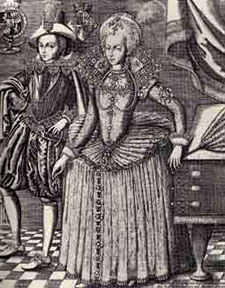
Frederick V, Elector Palatine, and Princess Elizabeth Stuart,
who
became the Winter King and Queen of Bohemia.
The Catholics imagined that, if coached by the right tutor,
Elizabeth
Stuart would become like her grandmother, tolerant towards both
Catholics and Protestants, embodying the spirit of the divine, seen
by them in terms of the Virgin Mary, the Catholic intermediary
between God and Earth. None of these ideals ever came to anything,
and the Catholic dream of emancipation would have to wait for
another two centuries (it came finally in 1829).
However,
Elizabeth's special place in history would be realized when in 1613,
just eight years after the failed Gunpowder Plot, she married
Frederick, elector of the Bavarian province of Palatine, and earned
the title 'Queen of Hearts'. In 1619 Frederick was offered and
accepted the crown of Bohemia, and together he and Elizabeth reigned
as the Winter King and Queen of Bohemia.
Frederick and Elizabeth's court at Heidelberg in Germany became a
centre for like-minded mystics, alchemists, artists, poets and
free-thinkers who saw the royal couple as the fulfillment of a
deeply mystical tract known as 'The Chemical Wedding of Christian Rosenkreutz', anonymously written and printed in 1616.
This recognized the union of the ideal king and queen, i.e. Frederick and
Elizabeth, bringing forth the anticipated new age of enlightenment,
marked, according to another 'Rosicrucian' (i.e. adherents of the
Rose upon the Cross) tract entitled 'Fama Fraternitatis' (1614), by
the appearance of two new stars, the one in Cygnus and another,
which had appeared in 1604 (Kepler's Star), in Ophiuchus, the
serpent holder.
The Rosicrucians practiced a magical philosophy
based very much on the Hermetic teachings, including the Emerald
Tablet, which, as we have seen, speaks of the One as the Supreme
Being.
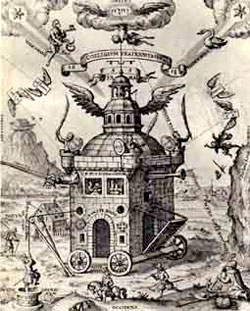
The Invisible College of the Rose Cross Fraternity
from the 17th
Century showing the new stars in Cygnus and Ophiuchus.
Back To Contents
ix. The Catholic Cause in England
Graham and I strongly suspected that even though Rosicrucianism was
primarily Protestant in religious persuasion, in England prior to
the Gunpowder Plot of 1605 it contained elements of Catholicism, an
assumption borne out by the fact that some of the earliest Freemason
lodges, particularly those in Yorkshire, where Guy Fawkes hailed
from, were strongly Catholic in nature.
Remember, during this age it
was the Catholics of England, Scotland and Ireland who kept alive an
interest not only in the Grail mysteries, but also in ancient and
sacred places, such as wells, hills, shrines and chapels, through
their devotion to the saints and saints' days, something that was
gradually being stamped out by fundamental Protestants known as
Puritans, who were tightening their political and religious grip on
the country during James' reign.
Both the English Catholics and the
more liberal-minded Protestants recognized what was going on, and so
their individual aims in the British Isles were not exclusive to
each other.
It was during the reign of James' second son, Charles I, that the
Puritans under Oliver Cromwell and his Parliamentarian Government
would finally bring the country to its knees and decimate all
surviving beliefs and practices associated with more traditional
forms of Christian worship, including the celebration of Christmas
and other annual festivals, such as May Day. Only with the death of
Cromwell in 1658 and the Restoration of the monarchy under Charles I's son, Charles II, would all of these religious beliefs and
practices reappear in Britain.
Charles and his circle of friends and
colleagues were unquestionably responsible for Britain's real age of
enlightenment, which was heavily supported by free-thinking
Protestants, Rosicrucian apologists and loyal Freemasons, united up
until this time under the name of the Invisible College, or the
Philosophical College. In 1662 it became the Royal Society of
London, which went on to pave the way for the age of scientific
reason, with great thinkers such as Sir Robert Boyle, Sir
Christopher Wren and Sir Isaac Newton at its helm.
Unconfirmed psychic information has suggested that Sir Isaac Newton
was a member of a Meonia-linked secret society, and played a major
role in crystallizing Meonia's inner philosophies concerning the
nature of the universe. Indeed, it has been implied on more than one
occasion that he employed the term 'Meonia' to refer to the highest
principle of the transmutation process.
In the knowledge that Newton
was a practicing alchemist with a great interest in unorthodox
religious ideas, such an idea remains a possibility. With the
gradual placing of his alchemical diaries online over the next
couple of years, perhaps the matter can be resolved one way or
another.
Back To Contents
x. The Swan in the Tower
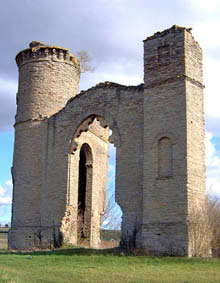
Dunstall Castle, nears Knights Hill Pool, subject of Gaynor's
swan in the tower dream.
The following day, Tuesday, 30 October 1979, Graham left early to
find out what he could about the Swan's Neck from the Worcester
County Records Office, and as I waited patiently to hear from him at
the Wolverhampton flat with Alan Beard and another friend Terry Shotton, who had arrived that morning,
Marion Sunderland called. She
said that Gaynor, who had retired to bed early, and so was not privy
to the latest information regarding the Swan's Neck, had experienced
a powerful dream overnight. Putting her on the line, Gaynor
explained how she had seen Graham, her and I ascending the tower at
Dunstall Castle once more.
Again, we had heard the sound of beating wings above us, but this
time instead of making a hasty retreat we had continued on up and
come face to face with a mighty swan, its wings outstretched as if
in a defensive position.
Around its neck was a pouch held in place by a cord that Gaynor was
convinced contained the Green Stone. As it took flight, we had run
back down the spiral staircase, with the bird in pursuit, and after
exiting the tower the swan had continued its flight across the
landscape to a location by running water, 'and this,' she said, 'is
where you will find the stone, on the neck of the swan'.
It was information that made sense of earlier psychic thoughts from
both Marion and Gaynor. Marion, for example, on holding
the Meonia
Sword following its discovery, had seen an avenue of popular trees
close to running water, feeling that this might be where the stone
was concealed, while Gaynor had seen a figure in seventeenth-century
style clothes running across open country towards a bridge over a
river or stream.
Around his neck was a pouch, the one now worn by
the swan, out of which he had removed a casket containing the stone
ready for burial nearby. Quite separately, both Alan and Terry had
drawn pictures of an arch-topped casket in which they believed the
stone would be found.
Back To Contents
xi. The Green Stone Found
Graham, still unaware of Gaynor's dream, was worried that a large
group of people tramping across open farmland towards a location on
the River Avon, was going to attract adverse attention. So he made a
difficult decision. He travelled out to the Swan's Neck, where after
walking on foot from nearby Eckington Bridge he saw that on the
approach to the bend was an avenue of poplars, like those seen in
mind by Marion.
Realizing that this was indeed the right location,
he deduced a suitable place of concealment and began digging. With
only a hole to show for his efforts, he moved on to another location
nearby, but this also produced nothing. Finally, he dug at the
summit of a low knoll out in a nearby field and at no great depth
Graham said he came across a casket, inside which was a small green
cabochon stone, close in size and appearance to the one seen in
vision by Alan Beard just thirteen days beforehand.
The casket, caked in earth, was found to be made of brass, and
matched the descriptions of the stone's predicted container as drawn
by Alan and Terry. Its appearance with arched lid and conical-shaped
legs was suggestive of a style popular during the second half of the
seventeenth century, although this was never confirmed.
The Green
Stone is thought to be made of agate. Its age cannot be estimated,
even though it looks to have been hand polished. Whether or not it
is linked with the Philosopher's Stone of the alchemists is open to
speculation. Following the completion of the quest, both the stone
and casket were given into the care of Marion Sunderland, who
championed the Green Stone story throughout her life.
Sadly,
following her death in 2005, Gaynor inherited the items and sold
them to an unknown bidder. Their
whereabouts today are unknown.
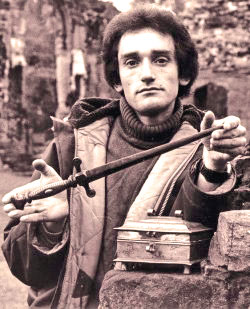
Graham Phillips with the sword and casket
Back To Contents
xii. Independent Verification of the Green Stone Story
Several years after these events I was put in touch with an elderly
couple who came from Eckington, Worcestershire. They lived in a
cottage just a few hundreds yards away from the Swan's Neck.
In a
letter (which I still have), the gentleman claimed that his father
had farmed the land adjacent to the Swan's Neck (although on the
opposite bank to the location associated with the Green Stone), and
one day, whilst out helping him in the fields, he was told the story
of the Green Stone.
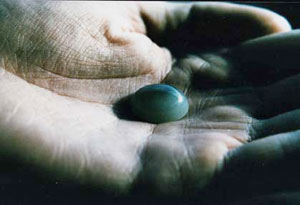
The Meonia Stone
It had been owned by a Catholic martyr attached to Harvington Hall
who was put to death for refusing to reveal its whereabouts.
Apparently, this priest had been protected by a member of the
family, who placed geese on the hall's long drive so that whenever
the Sheriff of Worcester's troops came to search the house the
birds' commotion would provide the household with enough time to
hide the priest in one of its many priest-holes.
I interviewed the elderly man, by then aged 90, at his home. He was
completely blind, and had only come to hear of our interest in the
Green Stone from his wife, who read an account of its discovery in a
local paper. He was actually quite incensed that we had distorted
the story told to him all those years beforehand.
Back To Contents
xiii. Lady Mary Yate and the Martyr of Harvington
Historical research indicated that the Catholic priest and martyr in
question was John Wall (1620-79), 'the martyr of Harvington'. He
regularly stayed at Harvington whilst ministering locally. Wall was
finally arrested, tried and executed at Worcester for practicing his
faith. Indeed, he became the last Catholic martyr in England. His
patron was Humphrey Packington's daughter Lady Mary Yate (nee
Packington), wife of Sir John Yate of Buckland, who inherited Harvington in 1631.
Like her father, she remained loyal to the
Catholic faith, and went out of her way to harbor John Wall, who is
commemorated in a stained glass window at the hall. Lady Yate died
in 1696, the same year that she founded the Harvington Secular
Clergy, which by the mid-eighteenth century already contained over
1,700 items on Catholic recusants. After her death, the estate
passed into the hands of the Throckmortons of Coughton Court, a
family intimately associated with both the Catholic cause and the
Gunpowder Plot.
If the elderly couple's story about John Wall was authentic, then
there seemed every likelihood that the real Green Stone was indeed
attached to Harvington Hall in Worcestershire. However, it was not
Humphrey Packington who concealed it, but most probably his daughter
Lady Mary Yate, perhaps with the help of John Wall.
Whatever the
reality of the story, it verified once and for all that the Green
Stone saga was not, as some might think, simply the creation of a
few individuals during the autumn of 1979. What is more, it seemed
definitely to be linked with Harvington Hall, a place first revealed
by 'Joanna' just hours after Alan Beard experienced his initial
vision of the Green Stone.
Back To Contents
xiv. The Rebirth of Psychic Questing
The writing up of these events in my book THE SWORD AND THE STONE
(1982), as well as within Graham Phillips' own book THE GREEN STONE
(1983), caused such a furore among the earth mysteries and
paranormal communities, that it single-handedly catalysed the
commencement of the modern-day revival in what I term psychic
questing.
This describes the spontaneous quest for answers to
mysteries presented through either dreams or more obvious psychic
means, such as automatic writing, meditations, mediumship or
visionary experiences. It is nothing new. Tibetan Buddhists had a
complete magical system in place for finding hidden religious
artifacts called termas, using similar processes.
It was practiced
mostly by the red-hatted Nyingma-pa monks and taught as part of the
mystical teachings known as Dzogchen. Derived most likely from the
pre-Buddhist, shamanic based Bon-po religion of Tibet, terma hunting
probably survives today in places such as Nepal, North India and
Mongolia.
Yet we know that psychic questing was once popular more closer to
home. There are plenty of accounts of Christian holy men or women
being led to retrieve relics through dreams and visions. Among them
are
-
Peter Bartholomew, the
visionary monk of the First Crusade who found the Spear of
Christ following the siege of Acre
-
Joan of Arc,
the French Maid of Orleans who was led by St Catherine to find the
sword of French folk hero Charles Martel
-
Mormon founder Joseph
Smith, who was instructed by the angel Moroni to retrieve gold
tablets from an Indian mound.
It was also a practice found among the alchemists and mystics of the
Middle Ages, who would invoke spirits to tell them where objects
were buried, Elizabethan magus and scholar Dr
John Dee and his
sidekick the alchemist and medium Edward Kelly being obvious
examples. In Glastonbury, they were led by spirits to a local
churchyard where they apparently retrieved phials containing the red
and white tinctures used in the alchemical process, as well as a
hand-written work on alchemy penned by a tenth-century abbot and
saint named Dunstan.
Also at Glastonbury, at the beginning of the twentieth century, new
age pioneer and mystic Wellesley Tudor Pole received a vision
suggesting that a holy vessel was to be found in a local holy well,
which was subsequently searched by his daughter and a friend. Here
they came across a sapphire-blue glass bowl of Venetian or Arabian
manufacture. Strangely, it transpired that the item had been
deliberately placed in the well only shortly beforehand by a man who
claimed that he was compelled by spirits to conceal it there so that
someone else might retrieve it.
Staying with Glastonbury, we must not overlook the psychic
archaeology of architectural historian Frederick Bligh Bond, who
whilst excavating the abbey during the 1910s and 1920s employed the
services of mediums who believed they could communicate with long
dead monks.
They instructed Tudor Pole on where to dig in order to
uncover previously unknown extensions of the medieval building,
including its lost Edgar Chapel and Loretto Chapel. All of this is
psychic questing, and it continues today. Aside from our own
website, check out
psychicquesting.com for the latest news and
information, as well as detailed discussions on the subject.
Back To Contents
xv. Meonia and Iona
MEONIA was used by us as a catch-all terms to describe those people
of the past whom unconfirmed psychic information suggested formed
part of a 'heritage' involving interlinked groups and individuals
connected in some way with either the Green Stone of the Meonia
Sword.
It is an incredible story spanning nearly 3,500 years, and is
outlined in our books. The term MEONIA has also been applied to
groups and individuals who have come together over the years in
order to further our knowledge of those involved in MEONIA's past;
indeed, we see it as carrying on from where they left off. It has
become like a banner, a flag of recognition, and embraces everything
from historical and field research to psychic questing, meditation
groups, and public events.
MEONIA thrives today with a core group,
made up of people who have had first hand experience in psychic
questing activities over the years.
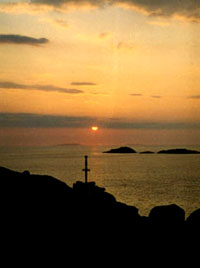
Sun setting off the coast of Iona, May Day 1980,
as seen from Dun Bhuriag, with the Meonia Sword in view.
Interestingly, MEONIA was found to be the Latin for Møn, or
Mona, an
island off the coast of Denmark (a merchant ship was named 'Meonia'
in honour of this particular island in 1927). More significant is
the fact that both Anglesey in North Wales and Iona in Scotland were
once called Mona (and thus bore the Latin name Meonia). As you will
see below, the holy island of Iona plays a special role in the Green
Stone story.
Early in 1980, Graham and I worked out that MEONIA was an anagram of
'I am One', and that it could further be broken up into two
components ME, as in I, and ONIA, which is an anagram of IONA. The
single letter 'I' was also an ancient Celtic name for the holy
island. Moreover, the founding saint of Iona's famous abbey, St
Columba (AD 521-97) was originally known as the Swan (Gaelic eala),
even though his name actually means 'dove'.
It was with such information that the first modern-day Meonia group
visited Iona for May Day 1980, conducting a two-part meditation at
sunrise and sunset in the name of St Michael the archangel of fire
in the belief that we were somehow activating the Green Stone.
Back To Contents
xvi. The Lights of Knowledge
As a consequence of this perceived activation process, the stone was
employed in January and February 1981 on a two part psychic quest in
an attempt to understand the wisdom of the megalithic peoples of
Britain, who built the stone circles, long barrows and standing
stones. This involved a monumental trip along a line of ancient and
sacred sites from Dorchester in Oxfordshire to the Hurlers double
stone circle on Bodmin Moor.
We subsequently came to realize that
many of the sites we had been guided to visit on the Lights of
Knowledge quest, as it was known, resonated with the Michael Line
(after St Michael). First highlighted in the late 1960s by earth
mysteries writer John Michell, it features an avenue or corridor of
sacred and ancient sites, many of which are dedicated to the
dragon-slaying saint. They fall on a straight line between Hopton-on-Sea
on the Norfolk coast and St Michael's Mount in Cornwall.
This fact
was made apparent following the publication in 1989 of a key book on
the Michael Line entitled THE SUN AND THE SERPENT by Paul Broadhurst
and Hamish Miller.
Back To Contents
xvii. The Seven Swords of Meonia
Beyond the Meonia story told thus far is the fact that in August
1985 a practicing Mormon named Colin Paddon started to receive vivid
dreams in which he saw an angel enshrouded by a blue haze who stood
in a wooded clearing (Joseph Smith's Moroni?). In its hands were two
identical swords, held by their blades point downwards. After the
dream had recurred a couple of times, Colin finally felt he
recognized the woodland in question as Brickhill Woods, near Woburn
Sands in Bedfordshire (where my biological mother lived when I was
conceived back in 1956).
Following a meditation at the Buddhist pagoda on Willen Lake, just
outside of Milton Keynes, Colin travelled out to Brickhill Woods one
Sunday afternoon with his family, which consisted of his wife Angela
and their two children, along with another family of two adults and
two children. In an attempt to locate the clearing seen in his
dream, Colin asked each of the adults to choose an azimuth bearing
between 0 and 360 degrees. One of the four angles was then followed
until it brought them to an obstacle.
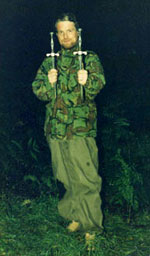
Colin Paddon in Brickhill Woods
holding the two swords as shown to
him in a dream.
Another angle was then chosen and followed until the same thing
happened again. This continued until finally, whilst following the
fourth and final trajectory, the party broke through knee-high
bracken and found themselves inside an untouched clearing,
recognized by Colin as the one from his dream.
In the centre, they removed the thick carpet of moss and immediately
saw two shiny sword pommels. On pulling at these, two untarnished
steel swords were slid out, much to the party's jubilation. They
were identical to each other, and the same as the same short swords
seen in the hands of the angel featured in Colin's recurring dream.
Only the following year did they realize that these were identical
to the one found by Graham and I at the Knights Hill Pool back in
1979 (indeed, they had never even heard of the Green Stone story
until the Meonia Sword was featured on a BBC documentary about the
Glastonbury zodiac, a subject very much associated with psychic
questing activities).
As Colin had touched the two swords for the first time, he felt that
others existed, seven in all, and that one day they would be brought
together for a very special purpose. And this was indeed what
happened. Four more swords, all identical to those already
described, would eventually be found in England under mysterious
circumstances. It is the search for the seventh and final sword that
became the subject of my book THE SEVENTH SWORD, published in 1991.
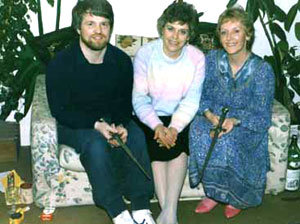
Marion Sunderland (centre) holds the Green Stone,
in the company of Colin and Angela Paddon with their two swords.
Back To Contents
xviii. A New Star in Cygnus
Even after this time we discovered that the new star which had
appeared in Cygnus, the swan, back in 1600, heralding for some an
impending new age of enlightenment, appeared in the neck of the
swan. When its position in relation to the rest of the celestial
swan was overlaid on to a map of the Swan's Neck, where Graham said
the Green Stone was found, the two positions corresponded perfectly.
Not only did this connect the stone with
the influence of Cygnus,
but it also indicated that there was a relationship between its
place of concealment and the new star of 1600. This was a startling
revelation which made me recall Gaynor Sunderland's remarkable dream
about the swan in the tower, experienced during the Green Stone
quest.
Back To Contents
xix. The Influences of Venus
The planetary influence of Venus, expressed in alchemy by the metal
copper and the colour green, governs Cygnus, the swan, which is
located centrally on the celestial river known as the Milky Way.
Venus features in alchemical philosophy, where her symbolic marriage
to the alchemist as Mercury, or Hermes, creates the androgynous
Mercurius, the culmination of the magical art.
All this suggests
that those behind the Green Stone's concealment were familiar not
only with alchemical ideals, but that the stone reflected the green
influence of Venus, connected with the sphere of Netzach in the Tree
of Life, the mystical religious system of the Hebrews adopted by the
Rosicrucians.
A second cabochon stone, an orange-red carnelian known as the Eye of
Fire (or Red Stone), was found subsequently in 1982 by Graham and
his friends (the quest occurred after I had withdrawn from the
group), and this unquestionably reflected the influence of Mercury,
the sphere of Hod on the Cabbalistic Tree of Life.
Venus and
Mercury, Netzach and Hod, green and red, are equal and opposites in
alchemical philosophy, creating a cosmic balance, reflected in
dualistic symbols such as the swan and the dragon, the bird and the
serpent, intelligence and matter, order and chaos, light and dark,
God and the devil, Cygnus and Draco. These are basic dualistic
principles still acknowledged today by those active in the psychic
questing community.
Back To Contents
xx. Bride-Bridget - the White Swan and Black Serpent
East of the Swan's Neck is Bredon Hill, a gigantic elevated plateau
that was once very likely the site of a British Iron Age (c.700
BC-AD 43) cult of the dead. This conclusion comes from the gruesome
discovery there of a whole series of skulls thought to have been
placed on spikes over an entrance gateway. It takes its name from
the suffix '-don', from the Old English dun, meaning 'hill', and the
prefix 'bre-', from the Welsh bre, also meaning 'hill'.
However,
this same word root gives us Bride, Bridget, Brig, or Bree, the name
of an ancient British and Irish goddess, worshipped under the name
Brigantia by the Brigantes, a powerful warrior tribe who at the time
of the Roman conquest inhabited much of northern Britain from
Hadrians Wall in the north down to Staffordshire's Peak District in
the south.
So powerful was Bride-Bridget as a pagan deity that even
with the arrival in Britain and Ireland of the earliest Christian
missionaries in the fifth century her cult could not be quelled, and
so instead of ignoring her, the pagan goddess was transformed into a
saint with a life of devotion to Christ.
One of Bride-Bridget's greatest totems is the white swan, and around
the time of her feast day, 1 February, an observer standing on the
hill's summit looking west will see a swan in flight formed by the
inundation of pastures around the Swan's Neck bend on the River
Avon. Such naturalistic phenomena would unquestionably have been
important to the geomythic beliefs of our ancestors, and expresses
once more the significance of the swan to the events surrounding the
story of Meonia.
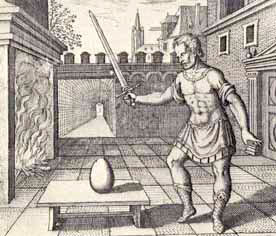
The Philosopher's Egg of the Rosicrucians.
As late as the seventeenth century in Cornwall and the nineteenth
century in Scotland, offerings of eggs, swan's down feathers and
even whole birds were made in the name of Bride-Bridget, and so it
is intriguing to find that the swan is renowned for laying green
eggs. Once again, we are reminded of Alan Beard's original vision of
the stone shrinking in size from that of a loaf of bread to an egg,
before becoming a ring stone worn on the hand of a woman.
The egg
was also an important symbol in alchemy and Rosicrucian philosophy,
with one picture showing a man in armour about to cut open a giant
egg with his sword. It represents a form of the Philosopher's Stone,
known as the Philosopher's Egg.
Bride-Bridget's other main totem is the snake, which in Scottish
folklore was said to rise annually out of its hollow hill on the
feast of St Bride. Thus within her is the perfect balance between
the swan and the serpent, the green and the red, light and darkness.
In many ways, she is a patron of psychic questing in Britain.
Bride-Bridget can be pictured holding a casket in which are two
stones, one green and the other red.
The rising energies from these
stones combine to form a double spiral in green and red, like the
DNA double helix, one of the most powerful symbols of human
evolution. Bridget, as Brigantia, might be seen in her warrior
aspect with long, flame red hair, wearing a green smock-like dress
and holding a bronze sword and shield.
In psychic questing lore, Brigantia is equated with a mythical
Bronze Age warrior queen named Gwevaraugh (pronounced gwev, as in
kevin, a(r), as in car, and raugh, as in martha) the prefix of whose
name derives from gwen, 'bright', the same as brig, or bric, the
root behind the name Bride-Bridget (Gwevaraugh can also linked with
the name Gwenhwyfar, or Guinevere, King Arthur's wife and consort in
Welsh and medieval tradition).
Unconfirmed psychic information
offered by 'Joanna' in October 1979 indicated that Gwevaraugh ruled
the Midlands of England around 900 BC from a fort called Bury Ring
near the town of Stafford. It was later implied during the Eye of
Fire quest of 1982 that Gwevaraugh possessed a magical sword on the
hilt of which the Green Stone and Red Stone (i.e. the Eye of Fire)
were affixed, creating a cosmic balance between the green and the
red.
The stones are said to have been removed from the sword at a
place called the Dovedales, an isolated valley in the Peak District,
noted for the appearance of mysterious lights and other strange
happenings. In many ways, Gwevaraugh has become synonymous with
Brigantia, the goddess of the Brigantes, who although an Iron Age
tribe, probably amalgamated with an existing Bronze Age ruling
family.
Back To Contents
xxi. The Cygnus Mystery
Much has happened since the naïve days of 1979, which unquestionably
inspired the prolific writing careers of both Graham Phillips and
myself. It is therefore not strange that the Cygnus constellation
should become the focus of my book THE CYGNUS MYSTERY, released by
Watkins Publishing in autumn 2006.
Even though this is strictly a
scholarly work, the main basis for the research project came from a
single, extremely weird night on 5/6 June 2004, following my recent
return from southeast Turkey, where I visited not only the oldest
temple in the world, which dates to 9500 BC, but also the remains of Harran. This ancient city of the star-worshipping Sabians is
celebrated as the birthplace of Hermetica, the philosophy based on
the Graeco-Egyptian writings of Hermes Trismegistus, such as the
text of the Emerald Tablet.
For nearly four hours that night I scribbled down inspired thoughts
and ideas, and those which have not inspired THE CYGNUS MYSTERY are
to be found in a mystical tract I wrote at the time entitled THE
CIRCLE OF CYGNUS. Its contents relate to the MEONIA story, and I
hope to publish this book in due course.
In THE CYGNUS MYSTERY I propose that cosmic rays from a binary star
system called Cygnus X-3 effected human evolution,
catalyzing the
emergence of the first universal religion and cosmology as early as
15,000 BC, and arguably earlier still. I suspect very much that our
Palaeolithic ancestors were aware of Cygnus's influence on their
lives, and even attempted to enhance this through cyclic initiations
and ceremonies in caves deep underground, where its signal is
clearer.
It is an influence that came to be personified in the
heavens as a cosmic bird of creation, variously seen as a swan,
vulture, hawk, dove, heron, magpie,
eagle or bird of paradise. It
was the basis behind concepts of the Supreme Being, such as
God,
Yahweh, Allah, the One, etc, as well as Cosmic Mothers, such as Nut
(or Nu-it), Hathor, Saraswati, Allat, al-Uzza, Venus, and
Bride-Bridget.
There is something very special about the influence of the Cygnus
constellation on the human mindset. It was seen in the past as the
source of cosmic life and death. Our most distant ancestors actually
believed that life came from this region of space, and that the
souls of the righteous would return there in death.
In many ways it
was the first location of heaven. Its counter-balance and rival in
the night sky is Draco, the celestial dragon, which
symbolizes the
abysmal realms of deep space, the void, or abyss, seen in some
ancient mythologies as a place where souls can be lost forever. As
Cygnus is the green ray, Draco signifies the red ray and together
they form a necessary cosmic balance in our own perspective of the
universe.
Back To Contents
xxii. Meonia.com
Cygnus exudes the influence of MEONIA more than any other stellar
source in the night sky. It is therefore not surprising that echoes
of its greater importance found their way into the discoveries of
1979. Somehow, we were drawn intuitively to the Swan's Neck, where
the Green Stone was supposedly buried by Catholic sympathizers in
the seventeenth century, and an elderly man of ninety years of age
was told the story of the fabled stone in his youth.
Whatever people
might think about the reality of these events, no one can deny the
strange manner in which they all came together, and no better word
than MEONIA expresses them, the reason why I have chosen to honour
the site with this name.
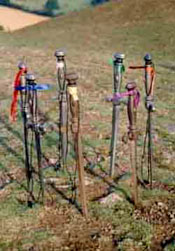
The Seven Swords of Meonia brought together
at Whiteleafed Oak on the borders of Herefordshire,
Gloucestershire and Worcestershire in August 1992.
Back To Contents
Booklist
Modern books dealing with psychic questing:
-
Carey, Grace, Web Quest (1996)
-
Collins, Andrew, The Sword and the Stone (1982); The Black Alchemist
(1988); The Seventh Sword (1992); The Second Coming (1993) and The
Twenty-First Century Grail (2004)
-
Gale, Jack, The Circle and the Square (1997)
-
Langstone, Alex, Bega and The Sacred Ring (1992)
-
Phillips, Graham, and Martin Keatman, The Green Stone (1984); The
Eye of Fire
-
Smith, Michael, The Sun and the Moon: The Hill and the Well (1997)
Back To Contents
|












